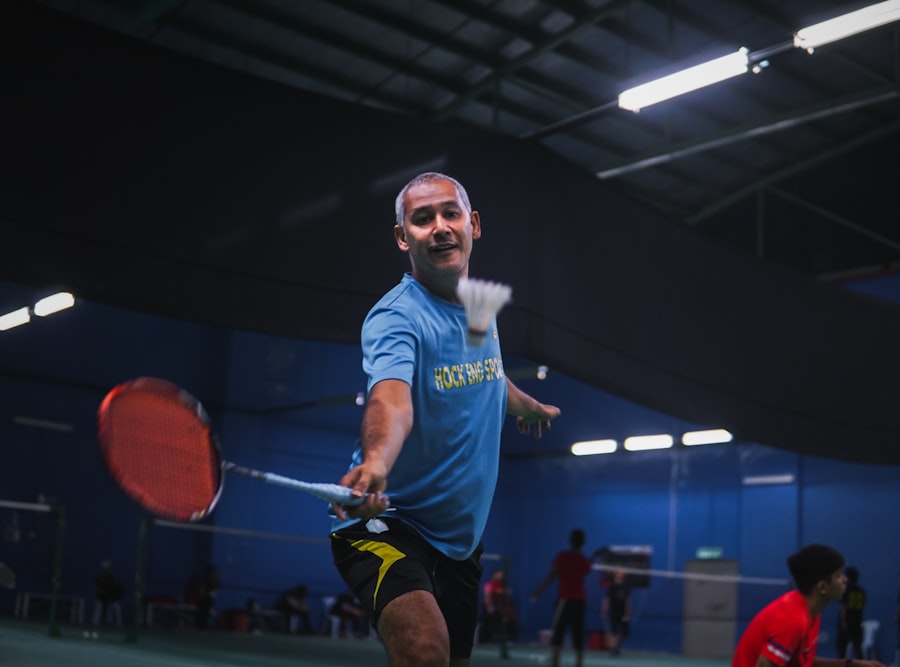Mastering the Art of Badminton: Tips for Success
Description
Badminton is a fast-paced racquet sport that has gained immense popularity worldwide, both as a competitive sport and a recreational activity. The game is played on a rectangular court divided by a net, with players using rackets to hit a shuttlecock back and forth. The objective is to score points by landing the shuttlecock in the opponent’s court while preventing them from doing the same.
The rules of badminton are relatively straightforward, making it accessible to players of all ages and skill levels. Each match can be played in singles or doubles format, adding an element of strategy and teamwork in the latter. The scoring system in badminton is known as rally scoring, where a point is awarded on every serve, regardless of which player served.
Matches are typically played to 21 points, and a player must win by at least two points. Understanding the basic rules, such as faults, serves, and scoring, is crucial for any aspiring player. Additionally, players must familiarize themselves with the dimensions of the court, which measures 13.4 meters long and 6.1 meters wide for doubles play, and 5.18 meters wide for singles.
The height of the net is set at 1.55 meters at the center, creating a challenging barrier that players must navigate.
Key Takeaways
- Badminton is a fast-paced racket sport played with a shuttlecock, requiring agility, speed, and precision.
- Proper footwork and movement are essential for covering the court efficiently and reaching the shuttlecock in time.
- Grip and racket control play a crucial role in executing different shots with accuracy and power.
- Mastering various types of shots, such as clears, smashes, and drops, is key to keeping your opponent off balance.
- Improving timing and anticipation helps in predicting your opponent’s moves and reacting quickly on the court.
Developing Proper Footwork and Movement
Footwork is one of the most critical aspects of badminton, as it directly influences a player’s ability to reach the shuttlecock effectively and execute shots with precision. Good footwork allows players to maintain balance and positioning, enabling them to respond quickly to their opponent’s shots. A common technique used in badminton is the “split step,” where players make a small jump just before their opponent strikes the shuttlecock.
This movement prepares them to move in any direction, enhancing their reaction time. Practicing footwork drills can significantly improve agility and speed on the court. For instance, players can set up cones or markers to create a course that mimics various shot scenarios.
By repeatedly moving to these markers while maintaining proper stance and balance, players can develop muscle memory that translates into better performance during matches. Additionally, incorporating lateral movements and backward sprints into training routines can help players become more versatile on the court, allowing them to cover ground more efficiently.
Perfecting Your Grip and Racket Control

The grip on the racket is fundamental to executing shots effectively in badminton. There are primarily two types of grips: the forehand grip and the backhand grip. The forehand grip is used for most shots and involves holding the racket as if shaking hands with it.
This grip allows for maximum power and control when hitting the shuttlecock. Conversely, the backhand grip requires a slight adjustment of the fingers to provide better leverage for backhand shots. Mastering both grips is essential for versatility during play.
Racket control goes hand-in-hand with grip technique. Players should practice various drills that focus on controlling the shuttlecock’s trajectory and spin. For example, practicing drop shots requires precise control over racket angle and speed.
Players can work on this by hitting the shuttlecock softly over the net from different positions on the court, gradually increasing difficulty by adjusting distance or adding movement before striking. This not only enhances racket control but also builds confidence in shot execution.
Mastering Different Types of Shots
| Shot Type | Definition | Importance |
|---|---|---|
| Forehand | A shot played with the racket in a vertical position and the palm of the hand facing the direction of the shot. | Allows for powerful and accurate shots. |
| Backhand | A shot played with the back of the hand facing the direction of the shot. | Essential for covering the other side of the court and maintaining balance. |
| Volley | A shot played before the ball bounces on the court. | Enables quick and aggressive play at the net. |
| Overhead Smash | A powerful shot played above the head when the ball is high in the air. | Effective for finishing points and putting pressure on opponents. |
A well-rounded badminton player must be proficient in various types of shots to keep opponents guessing and maintain an advantage during matches. The fundamental shots include clears, drops, smashes, and drives. Each shot serves a unique purpose; for instance, clears are used to push opponents to the back of the court, while drops are effective for catching them off guard with a sudden change in pace.
The smash is one of the most powerful offensive shots in badminton, executed by striking the shuttlecock at a steep angle downwards towards the opponent’s court. To master this shot, players should focus on timing their jump and racket swing to generate maximum power while maintaining accuracy. Practicing smashes from different positions on the court can help players develop consistency and confidence in their ability to finish points decisively.
Additionally, incorporating deceptive shots into practice routines can further enhance a player’s arsenal, allowing them to disguise their intentions and create openings against opponents.
Improving Your Timing and Anticipation
Timing is crucial in badminton; it can mean the difference between a successful shot and an unforced error. Players must develop an acute sense of timing to strike the shuttlecock at its peak height for optimal power and control. This skill can be honed through repetitive practice and by engaging in drills that emphasize rhythm and coordination.
Anticipation is equally important; it involves reading an opponent’s body language and shot selection to predict their next move. Players can improve their anticipation skills by watching their opponents closely during matches or practice sessions.
Enhancing Your Physical Fitness for Badminton

Physical fitness plays a pivotal role in badminton performance, as it directly impacts agility, endurance, strength, and overall athleticism. A well-rounded fitness regimen should include cardiovascular training to improve stamina, strength training for muscle power, and flexibility exercises to enhance range of motion. Activities such as running or cycling can boost cardiovascular endurance, allowing players to maintain high energy levels throughout matches.
Strength training should focus on key muscle groups used in badminton, including legs, core, and upper body. Exercises like squats, lunges, and planks can build strength essential for powerful shots and quick movements on the court. Additionally, incorporating plyometric exercises—such as box jumps or burpees—can enhance explosive power, which is vital for executing smashes and quick directional changes during play.
Flexibility training through yoga or dynamic stretching can prevent injuries and improve overall mobility, allowing players to reach for difficult shots more easily.
Mental Strategies for Success on the Court
Mental fortitude is often overlooked in sports training but is crucial for success in badminton. Players must cultivate focus, resilience, and strategic thinking to perform at their best under pressure. Visualization techniques can be particularly effective; by mentally rehearsing successful plays or strategies before matches, players can boost their confidence and reduce anxiety.
Additionally, developing a pre-match routine can help players enter a focused mindset before competing. This routine might include specific warm-up exercises, breathing techniques to calm nerves, or positive affirmations to reinforce self-belief. During matches, maintaining composure after mistakes is essential; players should practice mindfulness techniques that allow them to stay present rather than dwelling on past errors or worrying about future points.
Tips for Practicing and Training Effectively
Effective practice is key to improvement in badminton; however, simply hitting shuttlecocks back and forth is not enough. Players should set specific goals for each training session—whether it’s improving footwork speed or mastering a particular shot type—and focus on those objectives throughout practice. Keeping track of progress through journals or video analysis can provide valuable insights into areas needing improvement.
Incorporating variety into training sessions can also keep practice engaging and productive. Players might alternate between solo drills focusing on technique and partner drills that simulate match conditions. Additionally, participating in competitive sparring sessions with different opponents can expose players to diverse playing styles and strategies, further enhancing their adaptability on the court.
Lastly, seeking feedback from coaches or experienced players can provide new perspectives on technique and strategy that may lead to significant improvements over time.
If you’re a fan of Badminton, you may also be interested in checking out this article about the Panini Sticker Album here. It discusses the popular collectible sticker albums that have been a favorite among sports enthusiasts for years. These albums feature stickers of various athletes and teams, making them a fun and interactive way to engage with your favorite sports.
FAQs
What is badminton?
Badminton is a racquet sport played by either two opposing players (singles) or two opposing pairs (doubles), who take positions on opposite halves of a rectangular court divided by a net.
What equipment is used in badminton?
The primary equipment used in badminton includes a shuttlecock (also known as a birdie), badminton racquets, and a net. Players also wear appropriate footwear for the sport.
What are the basic rules of badminton?
The basic rules of badminton include serving diagonally, scoring points by landing the shuttlecock within the opponent’s court, and winning a match by winning two out of three games.
What are the health benefits of playing badminton?
Playing badminton can provide various health benefits, including improved cardiovascular fitness, agility, flexibility, and hand-eye coordination. It also helps in burning calories and promoting overall physical well-being.
What are the different types of badminton shots?
Some of the different types of badminton shots include the clear, drop shot, smash, drive, and the backhand shot. Each shot has its own specific technique and purpose during a game.
What are the major badminton tournaments and events?
Major badminton tournaments and events include the All England Open Badminton Championships, BWF World Championships, Thomas Cup (men’s team event), Uber Cup (women’s team event), and the Olympic Games. These events feature top players from around the world competing at the highest level.





